by Michael Gaige
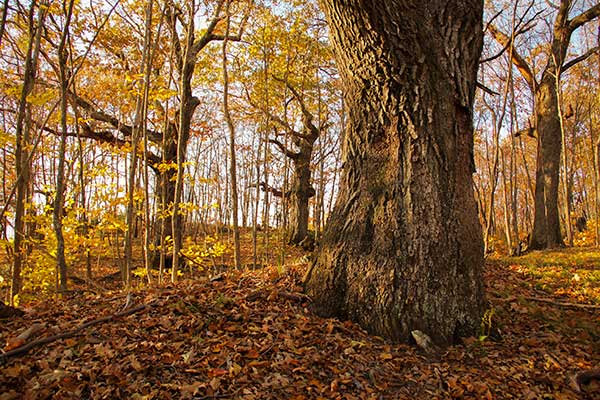
In the October 1945 issue of American Forests, in an article titled, “Woodman, Spare That Wolf Tree,” Charles Elliott writes, “…these ugly wolf trees, these snags, these trees classified as worthless space fillers are valuable wildlife units in the vast stretch of North American woodland.”
Elliott, contrary to popular sentiment at the time, was spot on. And nearly 70 years later, we’re due to revisit the wolf tree.
High above the shores of Lake Champlain, I trace a stone wall through a Vermont forest. Where the wall ends, I continue following a faint field line — where a hedgerow once ran — through sugar maple, basswood and eastern hemlock. At its end, I find the day’s first specimen: a huge white oak with a girth of over 15 feet and branches spreading into surrounding trees.
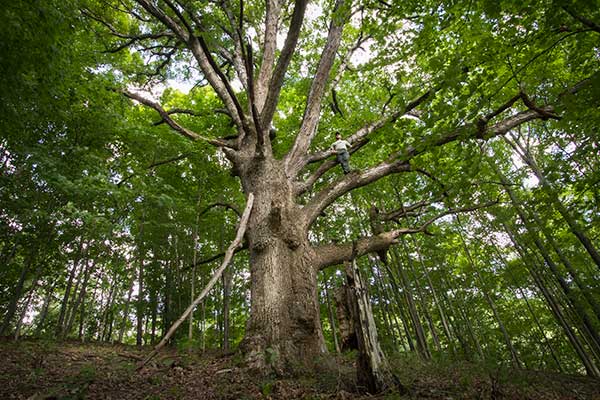
I’ve been hunting wolves for nearly a decade. Not four-legged wolves, but wolf trees in the eastern forest. Growing up as a forest rambler, and today as a practicing ecologist, I have always been lured to large, old trees, especially those in a forest setting.
This particular sweep of Vermont forest has a dozen of them: sugar maples, shagbark hickories and a number of massive white oaks. The white oak I encounter today, which I estimate to be approximately 300 years old, is the largest of them.
Happening upon such a gnarled, old tree, one cannot resist being pulled in. It is charismatic and animated. Its limbs reach wide, like arms. These are the trees of childhood imagination, the trees of fairy tales and folklore. These are the trees of sprites and gnomes and enchanted woodlands. Wolf trees are our Ents.
Wolf trees are also the storybooks of American history.
HISTORY OF THE WOLF TREE
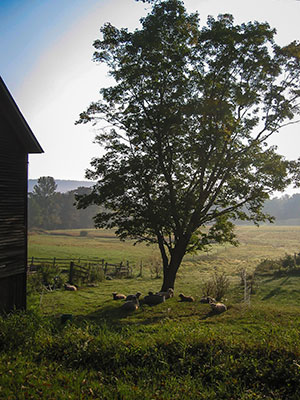
Arriving on the shores of North America, early European settlers and colonists encountered the wooded wilderness of the eastern deciduous forest. As agriculturalists and pastoralists, the forested landscape was unsuited to their land-use practices; it was an impenetrable fortress harboring fearsome beasts — not a place for cows and sheep and fields of barley.
But by axe and animal, colonists carved settlements out of the forest. They cut trees to build farms and villages, let livestock loose to browse forests into fields. Domestic animals were, perhaps, more effective at clearing land than axe-wielding humans. Within a few years of woodland grazing by cows, sheep, hogs and horses, the groundcover and understory trees would be gone, leaving an open woodland. With neighborly competition removed, the remaining trees were free to spread their branches far and wide.
By default or by decision, however, some trees remained in the pastures. On his walks around Concord, Mass., in 1860, Henry David Thoreau noted this process, somewhat anthropomorphically, in his journal, “ … pasture oaks are commonly the survivors or relics of old oak woods … as an old oak wood is very gradually thinned out, it becomes open, grassy, and park-like … This final arrangement is in obedience to the demand of the cow. She says, looking at the oak woods: ‘Your tender twigs are good, but grass is better. Give me at intervals for shade and shelter in storms, and let the grass grow far and wide between them.’”
But by the late 1800s and through the 1900s, the era of small-scale livestock farming as a viable living was sliding by. Northeastern farmers moved west to less rocky, more fertile ground. Later, small farms were supplanted by larger operations and economies of scale. Farms went under. Pastures were abandoned. And the remarkably resilient forest began its return.
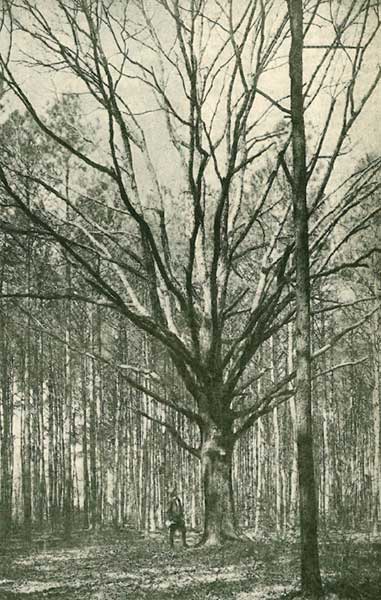
With the end of pastures we mark the beginning of wolf trees. As the art and science of forestry grew with the emerging forest, early foresters saw old shade trees as hindering, not helping, their bottom line. They suggested, as so many forestry books do, the spreading trees were like wolves, preying on forest resources and preventing the growth of smaller, marketable timber trees. Like wolves, they advised, pasture trees in the forest should be culled.
Foresters preferred tidy, well-managed timberlands and loathed the gnarled, snaking wolf trees for their unmarketable form. Charles Elliott summarizes this sentiment, writing that all the forestry books of the day treat the wolf tree as “a forest ulcer,” whose “elimination is a strict principle of forest management.” Elliott admits to having written such a book himself, but his outlook had changed as he came to see the importance of wolf trees to the eastern forests. “Woodman, Spare That Wolf Tree” marked his transition to an advocate for these forest giants.
Though Elliott’s is the earliest voice I have found that speaks positively of wolf trees, over the past couple of decades, sentiment toward wolf trees has started to change. Whereas during the latter half of the 1900s, when nearly all forestry texts advised the removal of wolf trees, a review today of forestry documents targeted to the landowner from extension offices and state resource agencies shows that about half note wolf trees’ virtues. This reflects the changing nature of forest management from a singular focus on timber to something encompassing forest ecosystems, human values and wildlife.
WOLF TREES TODAY

I walk around the base of the white oak looking into the branches and among the roots. The bark texture is coarse, showing its age. The ground is covered in slabs of fallen bark from branches now dying because of shade. Three carnivore scats left at the base post an olfactory “no trespassing” sign at what is the largest tree in the forest. Scats are typical at the bases of wolf trees, more common than “posted” signs put up by people (which also tend to occur on wolf trees).
Clearly, I’m not the first person to spend time at this tree. An old flip-flop lays half buried on the ground. And four rusty tree steps screwed into the trunk lead to the first live branch. I oblige, and make my way up.
The fat, low branch greets me with the husks of acorns and a half-eaten mushroom. A squirrel has eaten here with a commanding view of the forest; horizontal branches make fine places for resting and watching. Mosses and lichens cover the limbs. On closer inspection, insects, mites, spiders and other invertebrates occupy every cavernous niche. Earlier, I counted 80 distinct spider webs on the lower six feet of a sugar maple wolf tree. In the same tree, bees zoomed in and out of a hollow, while moths covered the inner walls, waiting for nightfall.
I climb higher into the oak wishing for the balance of a cat or wings of a bird. I reach a dead branch, chipped open by woodpeckers and hollowed by rot. Collected grass, falling from a hole, reveals the remnants of a nest. I rap on it to avoid surprises. Two hairy woodpeckers descend. Looking up, two more woodpeckers hitch around large limbs.

I watch a white-breasted nuthatch corkscrew down the trunk, gleaning the mites and insects I had seen hidden among the bark. Above, vireos work the highest branches for caterpillars and larger invertebrates. Perched in the center of the tree, I am encircled by a sphere of animal activity. Seemingly everywhere, life has embraced the opportunities presented by this tree.
Wolf trees also draw mammals, though they are challenging to see. In addition to carnivore scats, the bases of trees often reveal tunnels and dens of chipmunks or other small mammals. Cavities get filled by fox squirrels. I’ve found denning porcupines, raccoons and a young bear in wolf trees. Twice I discovered denning coyotes in the hollow bases of Kentucky chinkapin oaks. And though I haven’t looked specifically for them, bats likely use the loose bark or small cavities of wolf trees too.
I, like Elliott did in his observations, have found snakes tangled up in the spreading branches of wolf trees. The reptiles were probably awaiting the return of a bird or a chipmunk. Either way, the bustle of the wolf tree makes it a good place to wait for a meal.
I size up a nearby sugar maple: straight, tall, clear. I look closely for spiders, moths, scat or birds. I see nothing. Despite that it’s a lovely forest tree with great promise to a cabinetmaker, in comparison to the wolf tree, I find it woefully uninspiring.

In the early days of my wolf tree hunting, I studied the trees more systematically. I looked for animals at wolf trees, and I looked equally as hard in surrounding, commercially mature forest trees. I then compared the two to assess whether birds and mammals use wolf trees disproportionately to other trees. They do. Wolf trees offered opportunity to more individual animals from a greater number of species for longer periods of time than did typical forest trees. For every minute birds spent foraging in a typical forest tree, they spent 20 minutes foraging in wolf trees. For singing, the ratio was 30 to one.
Wolf trees are like the forest’s town square for animals. With their larger diameter, horizontal limbs, furrowed and sloughing bark, cavities and hollows, they offer more structural complexity than tall, straight, typical forest trees. Structural features don’t generally appear on eastern deciduous trees under 100 years old. In most of the eastern forest, old pasture trees have a 100- or 200-year leg-up on the surrounding trees and thus have had time to develop the features wildlife depend on.
In many forests, the abundance of certain bird or mammal species is limited by the abundance of cavities and hollows for them to dwell in. Because of this, ecologists consider such trees keystone structures; that is, their effect on the landscape is disproportionate to their abundance. Provide the animals with an opportunity, and they will use it. Without it, they don’t appear.
WOLF TREES IN THE FUTURE
Back on the ground, I observe the old white oak with admiration. This tree saw the birth of a nation. It saw forest turn to pasture and return again. Today, the forest closes in tight around it. Sugar maples push up through the oak’s branches; I count 60 maples rising from inside the drip line of the oak. A wall of maples and other species surrounds its outer limbs like an angry posse circling, well, a wolf.
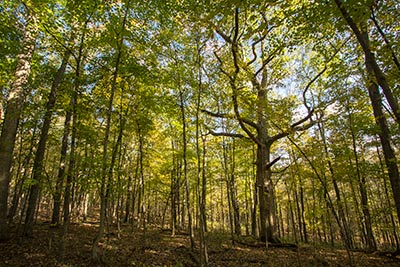
Though the threat of wolf tree culling still exists today, shade is perhaps a greater threat; trees that are not intentionally killed grow weaker as encroaching trees grow taller. I see this everywhere: Trees emerge around, through and beneath an old pasture tree. Because the old tree was shaped in full sun with a certain photosynthetic input to hold up its mass, shading forces the tree to shut down branches that no longer receive enough sun. The lower limbs on this oak, like most others, are dead. It’s hard to find a wolf tree today without senescent low limbs. In time, as neighborly competition dominates, a wolf tree’s new growth will reach up, not out.
There is a great irony here: Wolf trees have for a long time been scorned for shading emerging timber trees. But now, the reverse is true; surrounding trees are shading and killing the wolves.
The decline in wolf trees in the eastern forest corresponds with the decline in large, old trees globally. It takes a long time to grow a tree with features wildlife can use. On a human timescale, they are, essentially, a finite resource. In the eastern forest, wolf trees survive in a matrix of young trees that rarely surpass 100 years. So when the elders die, the young even-aged trees lack the complex structure of a healthy forest. But with some attention, we can slow the loss of wolf trees and preserve both wildlife habitat and our heritage.
Managing for the benefit of wolf trees is as simple as keeping the shade at bay (trees can also be trimmed and pruned to increase their longevity). In the United Kingdom, a similar phenomenon of ancient trees — called veteran trees — has attracted attention. The book Veteran Trees: A Guide for Good Management by Helen Read outlines how to manage young trees encroaching a veteran.

The same guidelines can be applied to wolf trees in the eastern forest. Encroaching trees can be thinned, ideally over several years so as not to shock the elder tree’s leaves, bark or roots. This is particularly true on southern aspects where a tree could be scorched, or on sides facing strong winds. Girdling emerging trees can work well, though falling branches and small trees can create a hazard for woodland walkers. Wildlife will appreciate the standing dead trees.
Because wolf trees are often oaks, keeping them makes good forestry sense too. Oaks in general, and white oaks in particular, are valuable timber trees that are in decline in many regions. The wolf tree has value as a seed tree, since, compared to typical forest trees, large, old trees are prolific seed producers.
I spend time at the Vermont oak writing down my observations and shooting photographs, trying to capture the history held within the tree. These are the most storied trees in the eastern forest. In their youth, they glimpsed Native American culture; in midlife, perhaps they hosted a colony of passenger pigeons. They witnessed the settling of the country as they shaded cows, sheep, people or all three. And today, as elders of the eastern forest, their legacy lies with wildlife; the birds, the bugs, the bears and all the beasts in between find opportunity in wolf trees.
The recognition that wolf trees have ecological and cultural significance is growing. Rather than labeling them as outlaws or rogues, we can celebrate their story and their important role in today’s eastern forest. Such an epiphany struck Charles Elliott 70 years ago when he said, “I take the stand as a character witness to wolf trees … dead, dying, and decaying trees are the most interesting places in the forest.”
I regard the white oak, turn my back and set forth to find the next one. Long live the wolf tree.
Michael Gaige became fascinated with wolf trees after hundreds of old tree encounters in the eastern forest. He is a freelance conservation biologist and educator based in Saratoga Lake, N.Y.